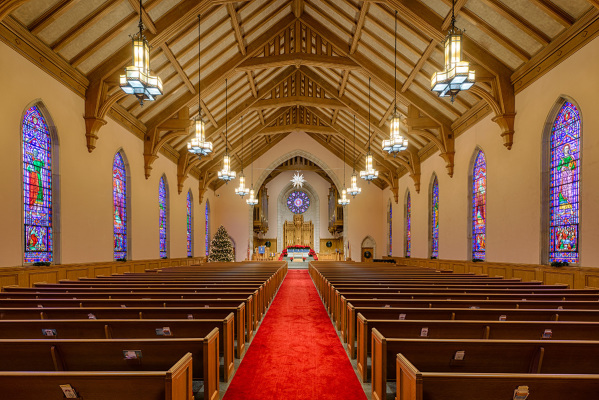A Word of Encouragement to United Methodists
Recently I retweeted an article from a Methodist leader entitled "Whatever Happened to the Missional Impulse of the Methodists?" In that post, Steve Manskar, Director of Wesleyan Leadership at GBOD (the General Board of Discipleship) of The United Methodist Church, speaks of his experience at the Exponential Conference:
Most of the people I met would identify themselves in the Calvinist/Reformed tradition. Very few would say they are Arminian or Wesleyan. While they likely disagree with Wesley theologically, they fully embrace his practices. United Methodists, on the other hand, sort of embrace the theology and neglect or outright reject Wesleyan practices. Why is that? That's a question I heard from a few of the people I met at Exponential.
Editorial comment: Steve calls them mostly Reformed, though when you are a United Methodist everyone else looks Reformed-- from my perspective, Exponential is hardly a Reformed crowd.
Steve does ask a good question, particularly if you know much about Methodist history.
In Viral Churches, Warren Bird and I described the situation as follows:
Shortly after the United States won its war for independence, people began moving westward in great numbers. The population shift was massive -- regions that had been virtually uninhabited in 1776 contained one - third of the nation's population by 1790. Wherever they went, a remarkable church planting movement swept through the American frontier. It resulted in multiple churches in virtually every county, city, town, and hamlet that settlers inhabited. The planting of new churches occurred at a rate that is almost unbelievable, especially because the blitz of church planting had no central hub.
The clear winners of the western frontier were the Baptists and Methodists. The most striking change of all was the growth of the Methodists from thirty small societies in 1776 to nearly 20,000 congregations in 1860 (see Table 4.1). Baptists, which were the second - largest denominational group by 1860, continued to grow, passing the Methodists in size before 1900. Today they are the largest Protestant faith group -- far larger than the New England - based Congregationalists that were the first to colonize this country (see Table 4.2 ), and pioneered the efforts of missionary work both among Native Americans and among Europeans who went west and north to unsettled areas.
In other words, it was the Methodists who were about much of the mission. Yet, today, they are struggling (on many fronts).
The missional impulse is about more than church planting, but Steve's blog post focused on such, and so will I in this one.
The United Methodists are seeking to revitalize their church planting efforts. You can see that through their "Path 1" emphasis (based on the Bishops "paths to the future). I've had the privilege to speak at a Path 1 meeting and they are starting strong. You might want to follow Gary Shockley on Twitter if you want to learn more.
But, this leads me to the reason I made this a rather long post...
Earlier this week I received an email from the Methodists' research folks. They have a strong crew in denominational research and they send out a helpful newsletter.
It is THIS kind of impulse that we could all use-- and learning from the Two Thirds World Christians would be a good step.
Here is the most recent "Background Data for Mission" from the UMC research folks.
"It's the Book of Acts" says Joseph Bishman, District Superintendent of the Shawnee Valley District in West Ohio Annual Conference. He is referring to the frontier United Methodist mission work in Vietnam, in which his district is heavily invested. The Vietnam UMC has grown from about four thousand folks to nearly 12,000 in the last four years. In their recent annual meeting with Bishop Bruce Ough, they expressed the goal of starting 100 new churches by year end 2012. Approximately 200 churches currently exist, nearly all of which were started since 2001. This is all the more remarkable, given the cultural and political context of this arm of our church.
A small United Methodist presence existed prior to the arrival of United Methodist missionaries Ut Van To and his wife Karen. Their initial work was mostly under the radar and with house churches. However, around 4 years ago, trade agreements required the country to open up their stance on religion and allowed more freedom, allowing for this growth. Of course, freedom alone does not cause this multiplication. Rev. Bishman observes that the primary factor is the driving focus of reaching new people for Christ. Their stated mission is "we exist to welcome people to Jesus Christ, equip them with a faith that's applicable in real life, and send them out to make disciples of Christ for the transformation of the world."
The strategy is well articulated:
■The class meeting or cell group is a gift that Methodism has been storing away from the whole Church, so it is time to resurrect the classes.
■Concentrate on forming and growing cell groups, and to develop curriculum for cell leaders and trainers.
■Organize training programs for cell leaders and training courses for the cell ministry.
■Bring many people to Christ through the cell groups.
■Ask our Bishop, GBGM, conferences, districts, and churches in the U.S. to support the vision and goals of the Vietnam Mission Initiative.
■Continue to follow up on the request to be officially recognized by the government.
■Continue to follow up on the application for UMCOR to be granted permission to operate in Vietnam.
On the ground, this all looks remarkably like early Methodism both in England and America. Trained leaders go to a new village or area and work on making relationships. This involves coordinating with government officials and often providing some kind of service, such as dealing with the impact of Agent Orange. As relationships are made, someone is eventually led to Christ and then meeting start in that home. In the midst of the Bible study and fellowship, neighbors are invited. Eventually more come to faith in Christ and ultimately a house church develops. The intent from the start is to build an ethos of using this as a training platform to send out other leaders to do the same in other places. While this model is not new (see Luke 10), the distinguishing feature here is that they really do it. Furthermore, the method is only part of the picture. It is accompanied by an intense faith and prayer life that is immediately apparent to American visitors.
Another aspect of the rapid growth has been the support through the General Board of Global Ministries' partnership program dubbed, "In Mission Together." This is a program where US churches can develop partnering relationships with churches in the mission initiative program of GBGM, such as in Vietnam. Of particular impact here is a relationship developed between a district and the entire mission initiative. West Ohio bishop, Bruce Ough, challenged Shawnee Valley district superintendent Joseph Bishman to take this on. They have done so remarkably. While this district is in Appalachia and has unimpressive economic credentials, they have still raised over a half million dollars over the course of three years for this ministry. The district has really owned this work and has many leaders who have been to Vietnam to participate in the work there. Rev. Bishman has even organized a stewardship motorcycle trip where Americans went to Vietnam, purchased motorcycles there, toured the ministry, and then left the bikes for the Vietnamese pastors. The motorcycle tour also resulted in over 300 baptisms along the way.
Rev. Bishman has challenged his district to be like the region the Apostle Paul challenged to take up an offering for the needs of the saints in Jerusalem. Shawnee Valley district has made the saints in Vietnam their Jerusalem. In a fascinating next step, they have gone to Vietnam and presented the UMC there with the possibility of taking on a Jerusalem of their own. After much intense (impressively so) prayer and discernment, the Vietnamese church has now chosen to do the same for another mission initiative area in their part of the world. Not only does this fledgling church have evangelism DNA, they are developing mission minded stewardship DNA as well. This stewardship development is making amazing progress in another area as well. They are working toward self-sustainability, with decreasing dependence on the US church for their basic needs. Nevertheless, the partnership relationship with the US churches will continue, but with the support funds being used for outreach rather than the pastors' salaries and other traditional needs.
Of course, problems and challenges exist in this frontier mission field. One of the district coordinators characterized some of these. "A few churches in the district are growing slow, a few pastors has yet to have a strategy to actively grow the church." "A few churches have not found a permanent location..." "The cell group ministry is still slow in deploying and therefore have not resulted in the successful church growth." "The development of a training program for pastors in the district is still slow and limited." He concludes, "Even though, the district still have its challenges, its weaknesses, with unmet goals, therefore pastors and members still need to work harder in order to reap more result for the kingdom of God in the new year. A-men." The striking aspect of these shortcomings is the height of the bar against which the ministry is measured. The goal for 2011 is no less than to "multiply and divide the district into two districts." One cannot help but contrast this assessment with the typical situation in US districts, which likely has no growth standards and strategy to reach them.
It's certainly exciting to find this pocket of the UMC reflecting our roots and experiencing dynamic, vital disciple making. Hopefully the US church can become infected by the life of this portion of our denomination. One way to connect is to partner with mission initiative churches. At any rate, we can be encouraged and inspired by those places in our connection, both in the US and abroad, where God is moving in fresh and powerful ways to fulfill our mission.
It's an important time for Methodism. It appears that many leaders are recognizing it to be so. I am not a Methodist, so (as I always am) I am an encourager from the outside, but I find these new developments interesting and encouraging. I am praying for my United Methodist sisters and brothers that God will use this time to direct them for His purposes.






















